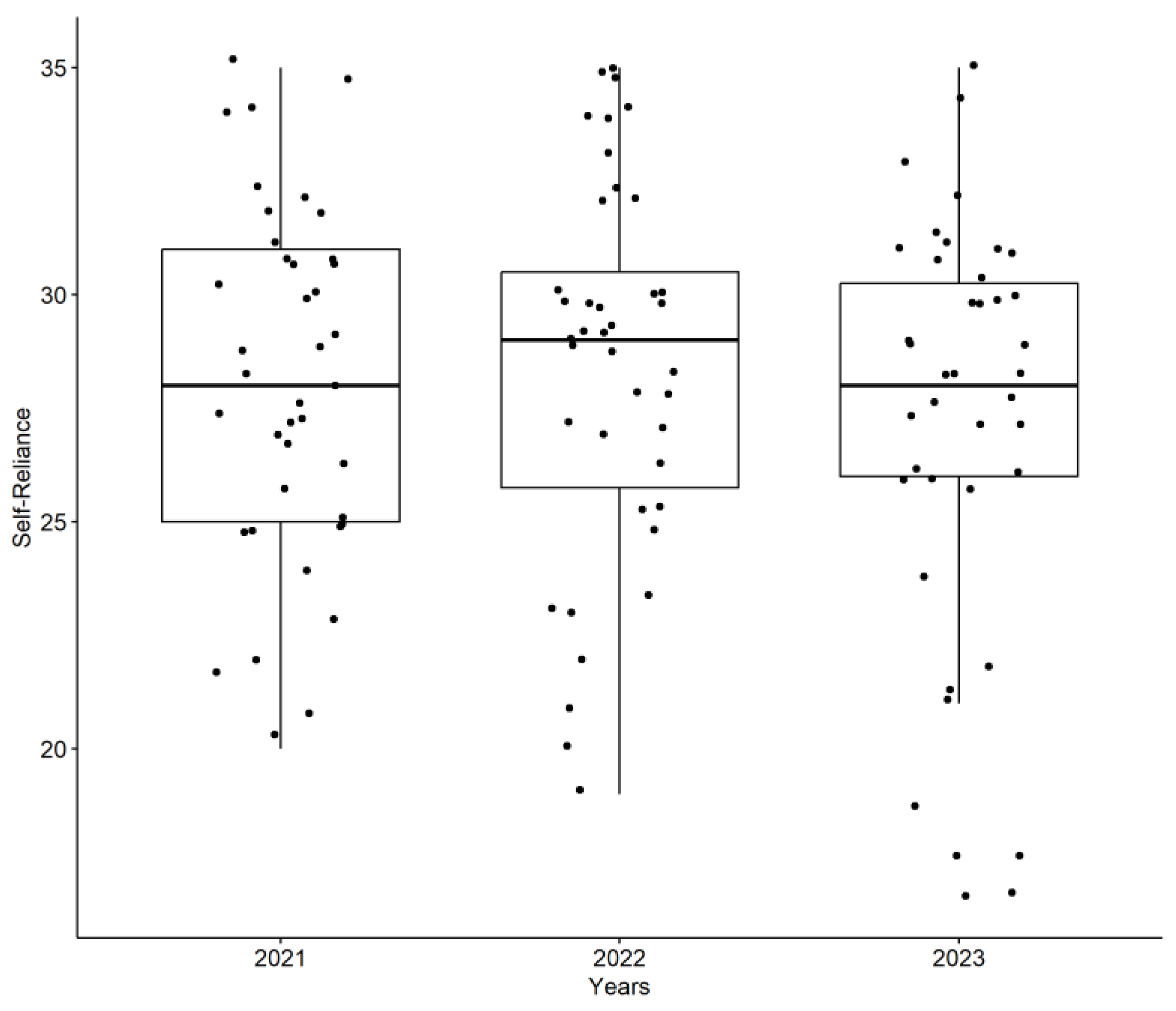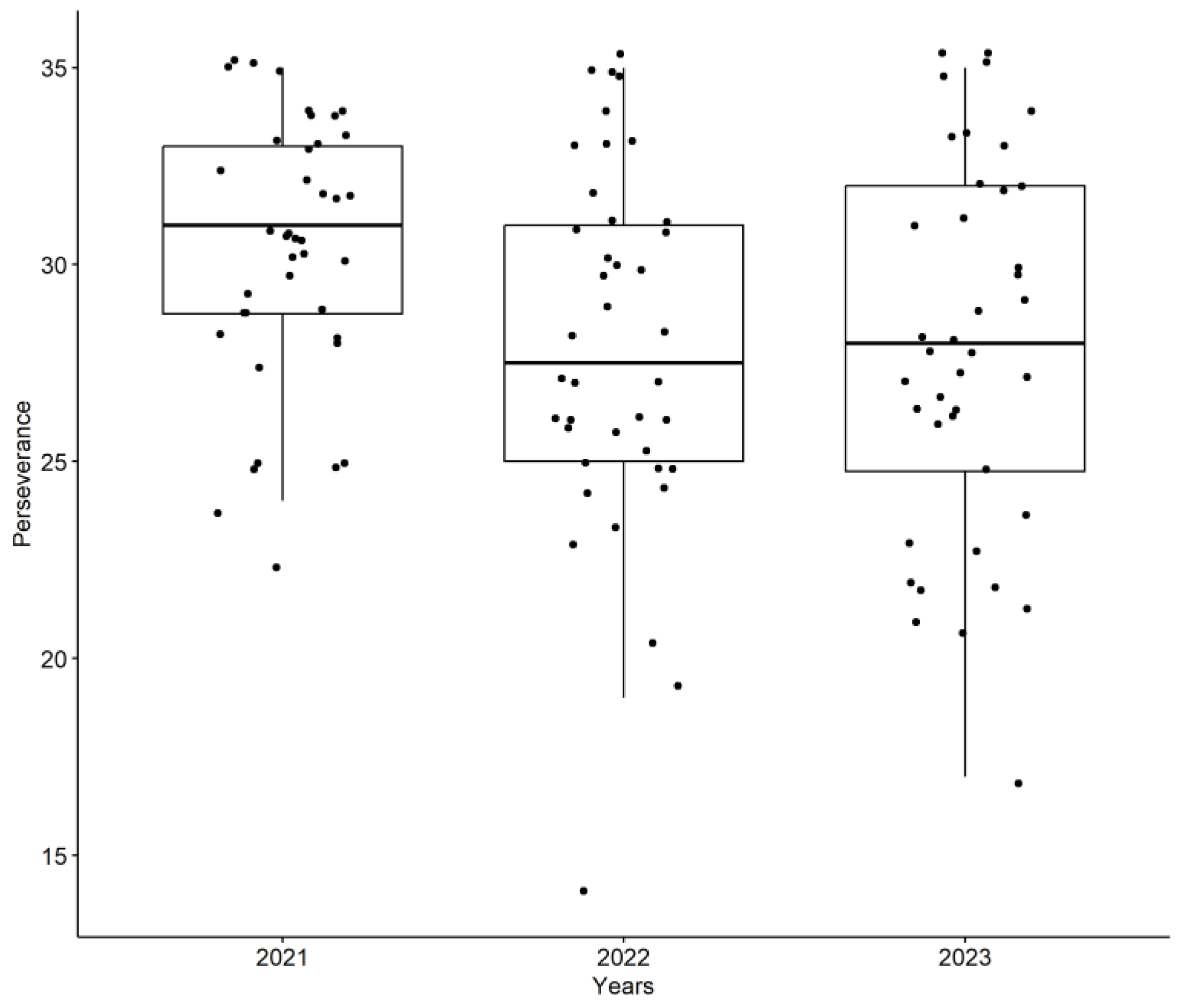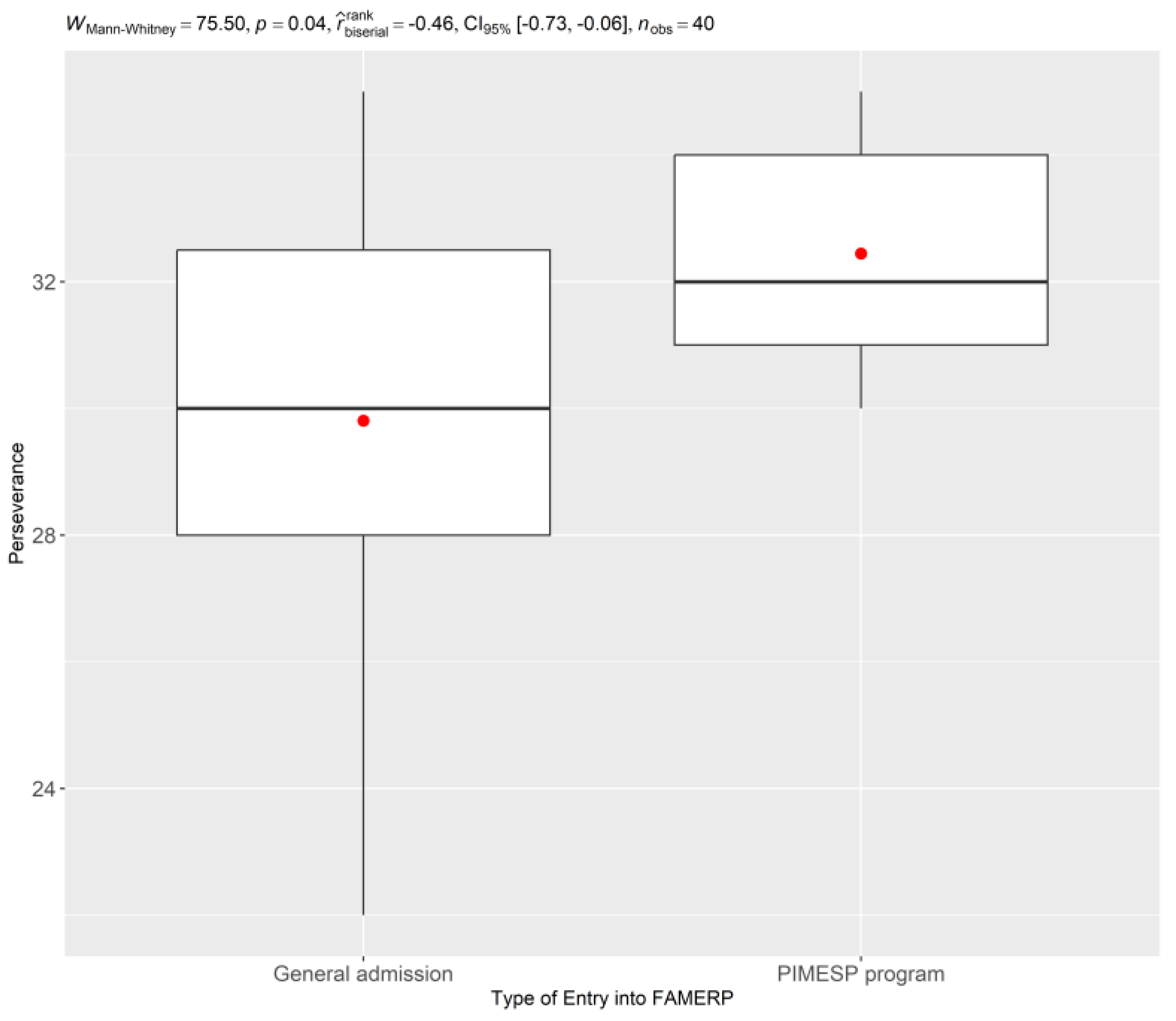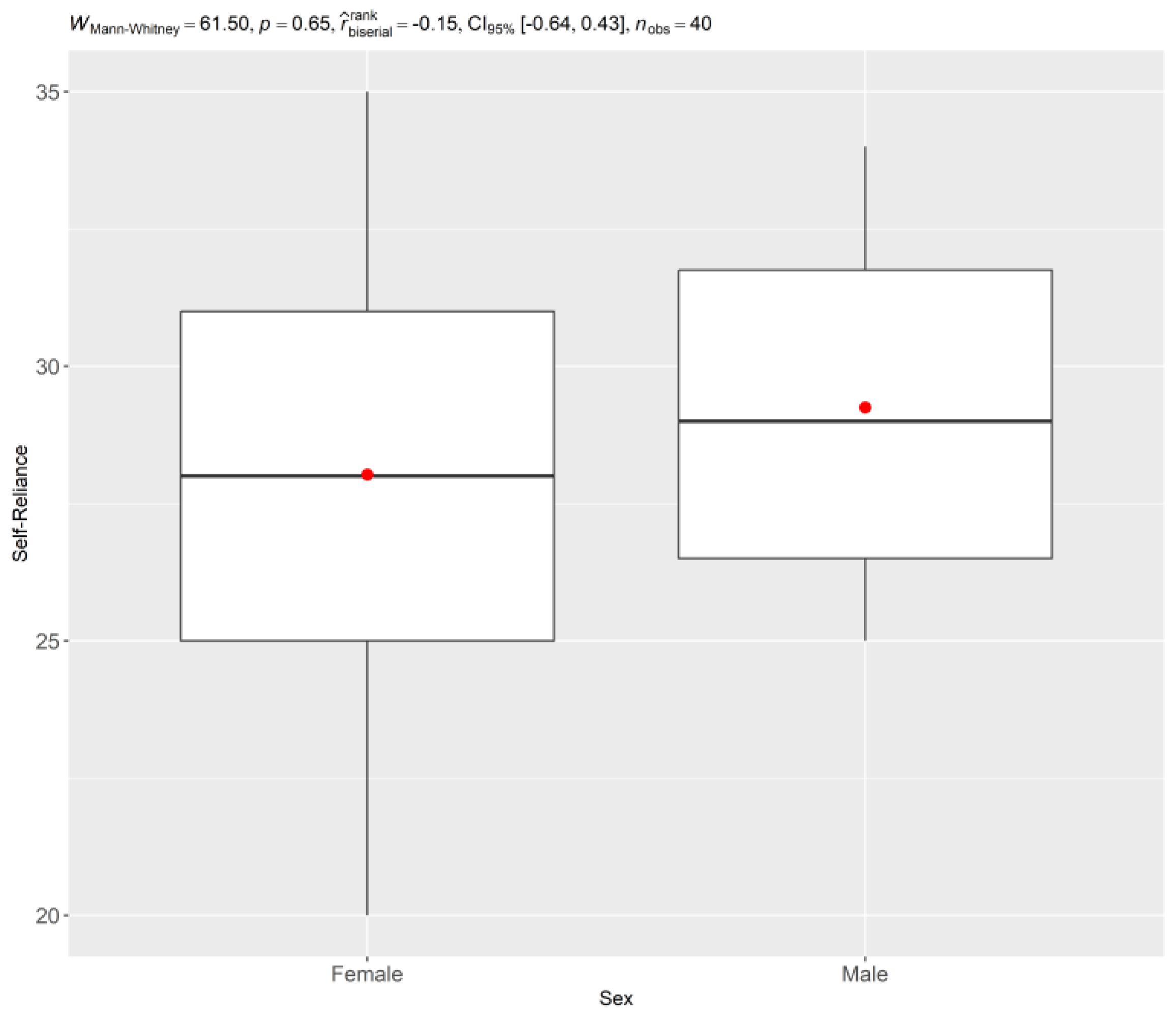Mental Health and Resilience in Nursing Students: A Longitudinal Study
Abstract
1. Introduction
2. Materials and Methods
2.1. Participants
2.2. Data Collection Instruments
- I.
- Term of Consent: An electronic Term of Consent (TC) was presented at the beginning of the form, ensuring that all participants were informed about the study’s objectives, procedures, potential risks and benefits, and their right to withdraw at any time without penalty.
- II.
- Sociodemographic and Professional Variables Questionnaire (SDVQ): This questionnaire, developed by the researchers, collected data on participants’ demographic characteristics (e.g., age, gender, marital status, socioeconomic status) and academic background (e.g., prior education, type of high school, previous higher education experience).
- III.
- Wagnild and Young Resilience Scale: The Brazilian version of the Wagnild and Young Resilience Scale was used to measure resilience levels [34,35]. This scale consists of 25 items, each rated on a 7-point Likert scale ranging from 1 (strongly disagree) to 7 (strongly agree). The scale assesses five dimensions of resilience [34]:
- Self-Sufficiency: Reflects a belief in one’s own competence and independence. This factor is assessed by items 4, 6, 11, 15, and 21, with possible scores ranging from 5 to 35.
- Meaning of Life: Indicates a sense of purpose and satisfaction with life. This factor is assessed by items 4, 6, 11, 15, and 21, with possible scores ranging from 5 to 35.
- Equanimity: Represents the ability to remain balanced and composed in the face of adversity. This factor is assessed by items 7, 12, 16, 19, and 22, with possible scores ranging from 5 to 35.
- Perseverance: Measures the capacity to persist in the face of obstacles and challenges. This factor is assessed by items 1, 10, 14, 20, and 24, with possible scores ranging from 5 to 35.
- Existential Singularity: Reflects a sense of connection to something larger than oneself and acceptance of life’s uncertainties. This factor is assessed by items 3, 5, 8, 17, and 25, with possible scores ranging from 5 to 35.
2.3. Data Collection Procedures
2.4. Data Analysis
2.5. Ethical Considerations
3. Results
4. Discussion
5. Conclusions
5.1. Social Impact
5.2. Implications for Education
5.3. Limitations
5.4. Future Perspectives
Author Contributions
Funding
Institutional Review Board Statement
Informed Consent Statement
Data Availability Statement
Conflicts of Interest
References
- Duarte, I.; Alves, A.; Coelho, A.; Ferreira, A.; Cabral, B.; Silva, B.; Peralta, J.; Silva, J.; Domingues, P.; Nunes, P.; et al. The Mediating Role of Resilience and Life Satisfaction in the Relationship between Stress and Burnout in Medical Students during the COVID-19 Pandemic. Int. J. Environ. Res. Public Health 2022, 19, 2822. [Google Scholar] [CrossRef] [PubMed]
- Forycka, J.; Pawłowicz-Szlarska, E.; Burczyńska, A.; Cegielska, N.; Harendarz, K.; Nowicki, M. Polish medical students facing the pandemic—Assessment of resilience, well-being and burnout in the COVID-19 era. PLoS ONE 2022, 17, e0261652. [Google Scholar] [CrossRef] [PubMed]
- Merino-Godoy, M.Á.; Yot-Domínguez, C.; Conde-Jiménez, J.; Ramírez Martín, P.; Lunar-Valle, P.M. The influence of emotional burnout and resilience on the psychological distress of nursing students during the COVID-19 pandemic. Int. J. Ment. Health Nurs. 2022, 31, 1457–1466. [Google Scholar] [CrossRef] [PubMed]
- Litwic-Kaminska, K.; Błachnio, A.; Kapsa, I.; Brzeziński, Ł.; Kopowski, J.; Stojković, M.; Hinić, D.; Krsmanović, I.; Ragni, B.; Sulla, F.; et al. Resilience, Positivity and Social Support as Perceived Stress Predictors among University Students. Int. J. Environ. Res. Public Health 2023, 20, 6892. [Google Scholar] [CrossRef]
- Gil-Hernández, E.; Carrillo, I.; Martin-Delgado, J.; García-Torres, D.; Mira, J.J. Development of a Web-Based Intervention for Middle Managers to Enhance Resilience at the Individual, Team, and Organizational Levels in Health Care Systems: Multiphase Study. JMIR Hum. Factors 2025, 12, e67263. [Google Scholar] [CrossRef]
- Tjimuku, M.; Atiku, S.O.; Kaisara, G. Emotional intelligence and psychological capital at work: A systematic literature review and directions for future research. Cogent Soc. Sci. 2025, 11, 2443559. [Google Scholar] [CrossRef]
- Casapulla, S.; Rodriguez, J.; Nandyal, S.; Chavan, B. Toward Resilience: Medical Students’ Perception of Social Support. J. Osteopath Med. 2020, 120, 844–854. [Google Scholar] [CrossRef]
- Williams, M.K.; Estores, I.M.; Merlo, L.J. Promoting Resilience in Medicine: The Effects of a Mind–Body Medicine Elective to Improve Medical Student Well-being. Glob. Adv. Health Med. 2020, 9, 2164956120927367. [Google Scholar] [CrossRef]
- Nielsen, C.; Katz, S.; Parker, M.; Trefsgar, J.; Bcharah, H.; Kalin, J.; Delavary, D.; Brunk-Grady, M.; Jaqua, B. A student-driven mindfulness curriculum for first-year osteopathic medical students: A pilot study. J. Osteopath Med. 2023, 123, 485–492. [Google Scholar] [CrossRef]
- Bandura, A. Self-efficacy: Toward a unifying theory of behavioral change. Psychol. Rev. 1977, 84, 191. [Google Scholar] [CrossRef]
- Duckworth, A.L.; Peterson, C.; Matthews, M.D.; Kelly, D.R. Grit: Perseverance and passion for long-term goals. J. Pers. Soc. Psychol. 2007, 92, 1087–1101. [Google Scholar] [CrossRef] [PubMed]
- Lam, K.K.L.; Zhou, M. Grit and academic achievement: A comparative cross-cultural meta-analysis. J. Educ. Psychol. 2022, 114, 597–621. [Google Scholar] [CrossRef]
- Joshi, I.; Zemel, R. COVID-19 and the New Hidden Curriculum of Moral Injury and Compassion Fatigue. Am. J. Hosp. Palliat Med. 2025, 42, 133–139. [Google Scholar] [CrossRef] [PubMed]
- Liu, Y.; Cao, Z. The impact of social support and stress on academic burnout among medical students in online learning: The mediating role of resilience. Front. Public Health 2022, 10, 938132. [Google Scholar] [CrossRef]
- Findyartini, A.; Greviana, N.; Putera, A.M.; Sutanto, R.L.; Saki, V.Y.; Felaza, E. The relationships between resilience and student personal factors in an undergraduate medical program. BMC Med. Educ. 2021, 21, 113. [Google Scholar] [CrossRef]
- El-Awaisi, A.; Ismail, S.; Sulaiman, R.; Kane, T.; El Hajj, M.S.; Shraim, M. A Qualitative Exploration of Health Profession Students’ Experiences of Resilience and Burnout Using the Coping Reservoir Model during the COVID-19 Pandemic. Teach Learn Med. 2024, 36, 256–268. [Google Scholar] [CrossRef]
- Huang, C.; Tu, Y.; He, T.; Han, Z.; Wu, X. Longitudinal exploration of online learning burnout: The role of social support and cognitive engagement. Eur. J. Psychol. Educ. 2024, 39, 361–388. [Google Scholar] [CrossRef]
- Savitsky, B.; Findling, Y.; Ereli, A.; Hendel, T. Anxiety and coping strategies among nursing students during the COVID-19 pandemic. Nurse Educ. Pract. 2020, 46, 102809. [Google Scholar] [CrossRef]
- Majrashi, A.; Khalil, A.; Nagshabandi, E.A.; Majrashi, A. Stressors and Coping Strategies among Nursing Students during the COVID-19 Pandemic: Scoping Review. Nurs. Rep. 2021, 11, 444–459. [Google Scholar] [CrossRef]
- Boyd, A.; Mealand, K.; Briggs Early, K.; Oestreich, E. Perceived Stress, Grit, and Self-Care Behaviors in First-Year Medical Students. Am. J. Lifestyle Med. 2023, 17, 803–812. [Google Scholar] [CrossRef]
- Nair, B.; Otaki, F.; Nair, A.F.; Ho, S.B. Medical students’ perception of resilience and of an innovative curriculum-based resilience skills building course: A participant-focused qualitative analysis. PLoS ONE 2023, 18, e0280417. [Google Scholar] [CrossRef] [PubMed]
- Gheihman, G.; Singh, T.A.; Cooper, C.A.; McKeon, B.A.; Hirsh, D.A.; Simpkin, A.L. Everyday Resilience: Equipping Faculty with Practical Exercises to Promote Resilience Among Medical Students. MedEdPORTAL 2021, 17, 11076. [Google Scholar] [CrossRef] [PubMed]
- Versel, J.; Plezia, A.; Jennings, L.; Sontag-Milobsky, I.; Adams, W.; Shahid, R. Emotional Intelligence and Resilience “PROGRAM” Improves Wellbeing and Stress Management Skills in Preclinical Medical Students. Adv. Med. Educ. Pract. 2023, 14, 1309–1316. [Google Scholar] [CrossRef]
- Sanjaya, A.; Mianto, N.A.; Wijayanto, K.R.; Edwin, C. Resilience: A panacea for burnout in medical students during clinical training?: A narrative review. Medicine 2024, 103, e40794. [Google Scholar] [CrossRef]
- McManus, S.; Killeen, D.; Hartnett, Y.; Fitzgerald, G.; Murphy, K.C. Establishing and evaluating a Balint group for fourth-year medical students at an Irish University. Ir. J. Psychol. Med. 2020, 37, 99–105. [Google Scholar] [CrossRef]
- Jordan, R.K.; Shah, S.S.; Desai, H.; Tripi, J.; Mitchell, A.; Worth, R.G. Variation of stress levels, burnout, and resilience throughout the academic year in first-year medical students. PLoS ONE 2020, 15, e0240667. [Google Scholar] [CrossRef]
- Haykal, K.A.; Pereira, L.; Power, A.; Fournier, K. Medical student wellness assessment beyond anxiety and depression: A scoping review. PLoS ONE 2022, 17, e0276894. [Google Scholar] [CrossRef]
- Antoun, J.; Khater, B.; Itani, H.; Naous, J.; Romani, M. Effectiveness of a modified Balint group process on empathy and psychological skills employing Kirkpatrick’s evaluation framework. PeerJ 2023, 11, e15279. [Google Scholar] [CrossRef]
- Gong, B.; Zhang, X.; Lu, C.; Wu, C.; Yang, J. The effectiveness of Balint groups at improving empathy in medical and nursing education: A systematic review and meta-analysis of randomized controlled trials. BMC Med. Educ. 2024, 24, 1089. [Google Scholar] [CrossRef]
- Abou Hashish, E.A.; Bajbeir, E.; Almabadi, S.A.; Alzebali, N.D.; Alhubishi, S.F. Investigating Quality of Life, Academic Resilience, and Influential Factors in Nursing Education: A Mixed-Methods Study among Nursing Students. SAGE Open Nurs. 2024, 10, 23779608241303690. [Google Scholar] [CrossRef]
- Mayor-Silva, L.I.; Meneses-Monroy, A.; Rodriguez-Leal, L.; Moreno, G. An Exploration of Resilience and Positive Affect among Undergraduate Nursing Students: A Longitudinal Observational Study. Nurs. Rep. 2024, 14, 871–882. [Google Scholar] [CrossRef] [PubMed]
- Gunasekara, F.I.; Richardson, K.; Carter, K.; Blakely, T. Fixed effects analysis of repeated measures data. Int. J. Epidemiol. 2014, 43, 264–269. [Google Scholar] [CrossRef] [PubMed]
- Cohen, J. A power primer. Psychol. Bull. 1992, 112, 155–159. [Google Scholar] [CrossRef] [PubMed]
- Wagnild, G.M.; Young, H.M. Development and psychometric evaluation of the Resilience Scale. J. Nurs. Meas. 1993, 1, 165–178. [Google Scholar]
- Pesce, R.P.; Assis, S.G.; Avanci, J.Q.; Santos, N.C.; Malaquias, J.V.; Carvalhaes, R. Adaptação transcultural, confiabilidade e validade da escala de resiliência. Cad. Saude Publica 2005, 21, 436–448. [Google Scholar] [CrossRef]
- R Core Team. RA Language and Environment for Statistical Computing; R Foundation for Statistical Computing: Vienna, Austria, 2020. [Google Scholar]
- Efron, B.; Tibshirani, R.J. An Introduction to the Bootstrap; Chapman and Hall/CRC: Boca Raton, FL, USA, 1994; ISBN 9780429246593. [Google Scholar] [CrossRef]
- Field, A. Discovering Statistics Using IBM SPSS Statistics, 6th ed.; SAGE Publications: Thousand Oaks, CA, USA, 2024; p. 1144. ISBN 1529668700/9781529668704. [Google Scholar]
- Saad, S.; Ali, S. Academic resilience in medical students: Exploring students’ perception of social support provided by peers and teachers to help at-risk students for the successful academic journey. BMC Med. Educ. 2025, 25, 271. [Google Scholar] [CrossRef]
- Gause, G.; Sehularo, L.A.; Matsipane, M.J. Factors That Influence Resilience among First-Year Undergraduate Nursing Students: A Cross-Sectional Descriptive Study. Nurs. Rep. 2024, 14, 1324–1337. [Google Scholar] [CrossRef]
- Rayani, A.M.; Alodhailah, A.M.; Alreshidi, S.M. A cross-sectional study of resilience and well-being among nursing students in Saudi Arabia. SAGE Open Med. 2024, 12, 20503121241245224. [Google Scholar] [CrossRef]
- Aryuwat, P.; Holmgren, J.; Asp, M.; Lövenmark, A.; Radabutr, M.; Sandborgh, M. Factors Associated with Resilience among Thai Nursing Students in the Context of Clinical Education: A Cross-Sectional Study. Educ. Sci. 2024, 14, 78. [Google Scholar] [CrossRef]
- Kondo, A.; Abuliezi, R.; Niitsu, K.; Naruse, K.; Oki, T.; Ota, E.; Ezeonwu, M.C. Factors related to mental health effect among nursing students in Japan and the United States during the coronavirus pandemic: A cross-sectional study. Int. J. Ment. Health Nurs. 2023, 32, 186–198. [Google Scholar] [CrossRef]
- Rosales-Ricardo, Y.; Rizzo-Chunga, F.; Mocha-Bonilla, J.; Ferreira, J.P. Prevalence of burnout syndrome in university students: A systematic review. Salud Ment. 2021, 44, 91–102. [Google Scholar] [CrossRef]
- Kong, L.N.; Yao, Y.; Chen, S.Z.; Zhu, J.L. Prevalence and associated factors of burnout among nursing students: A systematic review and meta-analysis. Nurse Educ. Today 2023, 121, 105706. [Google Scholar] [CrossRef] [PubMed]
- Moxham, L.; Roberts, M.; Yousiph, T.; Lewer, K.; Jay, E.K.; Robson, G.; Patterson, C. “This should be a compulsory placement for all nursing students”: An evaluation of pre-registration nursing students’ perceptions of learning on a mental health clinical placement. Nurse Educ. Pract. 2024, 79, 104077. [Google Scholar] [CrossRef] [PubMed]
- Sitwira, J.; Ashipala, D.O.; Katjimune, V. Nursing students’ experiences of clinical competency evaluation in a pre-registration nurse education programme: A qualitative study. Curationis 2025, 48, 9. [Google Scholar] [CrossRef]
- Hwang, E.H.; Kim, K.H. Relationship between optimism, emotional intelligence, and academic resilience of nursing students: The mediating effect of self-directed learning competency. Front. Public Health 2023, 11, 1182689. [Google Scholar] [CrossRef]
- Malik, L. Role of Compassion Fatigue and Burnout in Existing and Upcoming Interventions for Mental Health Professionals: A Literature Review. J. Appl. Conscious. Stud. 2024, 12, 45–51. [Google Scholar] [CrossRef]
- Stevens, K.; Al-Abbadey, M. Compassion fatigue and global compassion fatigue in practitioner psychologists: A qualitative study. Curr. Psychol. 2024, 43, 7259–7274. [Google Scholar] [CrossRef]
- Cutuli, J.J.; Herbers, J.E.; Masten, A.S. Reed MGjdxsee Resilience in Development. In The Oxford Handbook of Positive Psychology; Snyder, C.R., Lopez, S.J., Lisa, M., Edwards, S.C.M., Eds.; Oxford University Press: New York, NY, USA, 2020; p. 792. ISBN 0199396523/9780199396528. [Google Scholar]
- Kalisch, R.; Russo, S.J.; Müller, M.B. Neurobiology and systems biology of stress resilience. Physiol. Rev. 2024, 104, 1205–1263. [Google Scholar] [CrossRef]
- Chauhan, V.; Saxena, T. Yoga and mindfulness in educational settings: Impact on student well-being and performance. J. Res. Adm. 2024, 6, 707–720. [Google Scholar]
- Wang, X. Exploring the impact of mindfulness, subjective well-being, and music engagement on academic performance of students in higher educational institutions. Humanit. Soc. Sci. Commun. 2025, 12, 305. [Google Scholar] [CrossRef]
- Polit, D.F.; Beck, C.T. Generalization in quantitative and qualitative research: Myths and strategies. Int. J. Nurs. Stud. 2010, 47, 1451–1458. [Google Scholar] [CrossRef]
- Surma-aho, A.; Hölttä-Otto, K. Conceptualization and operationalization of empathy in design research. Des. Stud. 2022, 78, 101075. [Google Scholar] [CrossRef]




| Year | |||
|---|---|---|---|
| Resilience Factor | 2021 | 2022 | 2023 |
| Self-Sufficiency | 28.15 (3.85) | 28.43 (4.22) | 27.13 (4.72) |
| Meaning of Life | 27.95 (2.19) | 26.33 (3.42) | 26.75 (2.84) |
| Equanimity | 24.55 (4.38) | 25.25 (4.62) | 23.33 (4.15) |
| Perseverance | 30.40 (3.37) | 27.95 (4.70) | 27.85 (4.68) |
| Existential Singularity | 27.83 (4.45) | 27.10 (4.88) | 27.23 (5.20) |
| Year | |||||
|---|---|---|---|---|---|
| Resilience Factor | 2021 | 2022 | 2023 | p-Value * | Effect Size † |
| Self-Sufficiency | 28.15 (3.85) | 28.43 (4.22) | 27.13 (4.72) | 0.3857 | 0.0241 |
| Meaning of Life | 27.95 (2.19) | 26.33 (3.42) | 26.75 (2.84) | 0.1200 ‡ | 0.0927 |
| Equanimity | 24.55 (4.38) | 25.25 (4.62) | 23.33 (4.15) | 0.1148 | 0.0540 |
| Perseverance | 30.40 (3.37) | 27.95 (4.70) | 27.85 (4.68) | 0.0131 | 0.1051 |
| Existential Singularity | 27.83 (4.45) | 27.10 (4.88) | 27.23 (5.20) | 0.7851 | 0.0062 |
| Pairwise Comparisons | ||||||
|---|---|---|---|---|---|---|
| 2021 vs. 2022 | 2021 vs. 2023 | 2022 vs. 2023 | ||||
| Resilience Factor | p-Value | TDE (IC 95%) | p-Value | TDE (IC 95%) | p-Value | TDE (IC 95%) |
| Perseverance | 0.027 | 0.570 0.147; 0.994 | 0.021 | 0.594 0.171; 1.016 | 1.000 | 0.023 −0.479; 0.525 |
Disclaimer/Publisher’s Note: The statements, opinions and data contained in all publications are solely those of the individual author(s) and contributor(s) and not of MDPI and/or the editor(s). MDPI and/or the editor(s) disclaim responsibility for any injury to people or property resulting from any ideas, methods, instructions or products referred to in the content. |
© 2025 by the authors. Licensee MDPI, Basel, Switzerland. This article is an open access article distributed under the terms and conditions of the Creative Commons Attribution (CC BY) license (https://creativecommons.org/licenses/by/4.0/).
Share and Cite
Martinez, W.D.; Casaleiro, T.; Menezes, J.D.d.S.; da Silva, M.Q.; Santos, E.R.d.; Franco, R.F.; Quiterio, A.B.; de Barros, T.G.; Silva, A.J.d.D.; Lopes, L.O.M.; et al. Mental Health and Resilience in Nursing Students: A Longitudinal Study. Int. J. Environ. Res. Public Health 2025, 22, 735. https://doi.org/10.3390/ijerph22050735
Martinez WD, Casaleiro T, Menezes JDdS, da Silva MQ, Santos ERd, Franco RF, Quiterio AB, de Barros TG, Silva AJdD, Lopes LOM, et al. Mental Health and Resilience in Nursing Students: A Longitudinal Study. International Journal of Environmental Research and Public Health. 2025; 22(5):735. https://doi.org/10.3390/ijerph22050735
Chicago/Turabian StyleMartinez, William Donegá, Tiago Casaleiro, João Daniel de Souza Menezes, Matheus Querino da Silva, Emerson Roberto dos Santos, Rauer Ferreira Franco, Alex Bertolazzo Quiterio, Thales Guardia de Barros, Ana Julia de Deus Silva, Luiz Otávio Maciel Lopes, and et al. 2025. "Mental Health and Resilience in Nursing Students: A Longitudinal Study" International Journal of Environmental Research and Public Health 22, no. 5: 735. https://doi.org/10.3390/ijerph22050735
APA StyleMartinez, W. D., Casaleiro, T., Menezes, J. D. d. S., da Silva, M. Q., Santos, E. R. d., Franco, R. F., Quiterio, A. B., de Barros, T. G., Silva, A. J. d. D., Lopes, L. O. M., Lopes, S. M. M., Castro, N. A. d. A. S. R., Lázaro, C. A., Fabris, M. L., Faria, J. I. L., Júnior, F. N. F., Pinto, M. H., Pompeo, D. A., Oliani, D. C. M. V., ... André, J. C. (2025). Mental Health and Resilience in Nursing Students: A Longitudinal Study. International Journal of Environmental Research and Public Health, 22(5), 735. https://doi.org/10.3390/ijerph22050735












